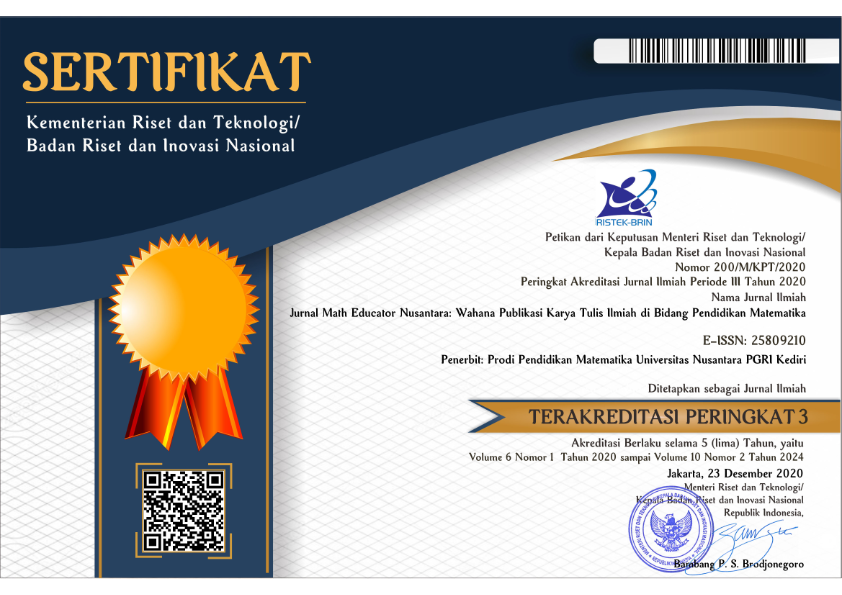Analysis of high school students' difficulties in solving hots problems using the two-tier test method
DOI:
https://doi.org/10.29407/jmen.v9i2.20822Keywords:
Student Difficulties, HOTS problems, Two Tier TestAbstract
High Order Thinking Skills (HOTS) are high-order thinking skills that should be owned and improved by Indonesian students to catch up with other countries, especially in the field of mathematics. This study aims to identify and describe students' difficulties in solving HOTS questions through the two-tier test method at MAN 3 Aceh Tengah. This research is a qualitative-research with document data sources on test answers, questionnaires, and interviews. The research subjects in this study were 3 subjects from class XII at MAN 3 Central Aceh. Analysis of the validity of the data used triangulation techniques, namely identifying and describing the difficulties faced by students when solving HOTS questions by analyzing the results of test answers, questionnaires and interviews. The results of the research show specifically and descriptively that students when solving analyzing indicator questions feel anxious, lack self-confidence and are unable to process information into the form of solving mathematics. In the evaluating indicator, students are not sure they can solve the questions given. So that students fail to understand the concept of solving the problems presented. Meanwhile, in the creating indicator, students still have difficulty developing their own ideas. In the indicator of creating, students are only monotonous in what the teacher teaches, without developing their creativity to solve the given problem.
References
Aji, A., Tias, W., & Wutsqa, D. U. (2015). Analisis Kesulitan Siswa SMA dalam Pemecahan Masalah Matematika Kelas XII IPA di Kota Yogyakarta. Jurnal Riset Pendidikan Matematika, 2(1), 28–39. https://doi.org/10.21831/jrpm.v2i1.7182
Bayrak, B. K. (2013). Using Two-Tier Test to Identify Primary Students’ Conceptual Understanding and Alternative Conceptions in Acid Base. Mevlana International Journal of Education, 19–26. https://doi.org/10.13054/mije.13.21.3.2
Chou, C., Tsai, C.-C., & Chan, P.-S. (2007). Developing a web-bascd two-tier test for internet literacy. In British Journal of Educational Technology (Vol. 38, Issue 2, pp. 369–372). https://doi.org/doi:10.1111/j.1467-8535.2006.00644.x
Dwidarti, U., Mampouw, H. L., & Setyadi, D. (2019). Analisis Kesulitan Siswa dalam Menyelesaikan Soal Cerita Pada Materi Himpunan. Journal Cendekia: Jurnal Pendidikan Matematika, 03(02), 315–322. https://doi.org/10.31004/cendikia.v3i2.110
Girsang, R. A., Bunawan, W., & Juliani, R. (2020). Development of Two-tier Multiple Choice Instrument to Measure Higher Order Thinking Skills. 4th Annual International Seminar on Transformative Education and Educational Leadership, 384(Aisteel), 429–434. https://doi.org/10.2991/aisteel-19.2019.94
Gradini, E., Firmansyah, B., & Noviani, J. (2018). Calon Guru Matematika Melalui Level Hots Marzano. EduMa, 7(2), 41–47.
Hadi, S. (2019). TIMSS Indonesia ( Trends in Iinternational Mathematics and Science Study ). Prosiding Seminar Nasional & Call For Papers, Program Studi Magister Pendidikan Matematika Universitas Siliwangi, 562–569. https://jurnal.unsil.ac.id/index/php/sncp/article/view/1096
Kaukab, S. R. (2016). The Impact of Parent/Family Involvement on Student Learning Outcomes. International Journal of Research-Granthaalayah, 4(10), 72–81. https://doi.org/10.5281/zenodo.164925
Lisnani, Zulkardi, Putri, R. I. I., & Somakim. (2020). Etnomatematika: Pengenalan Bangun Datar Melalui Konteks Museum Negeri Sumatera Selatan Balaputera Dewa. Mosharofa, 9(3), 359–370. https://doi.org/10.31980/musharofa.v9i3.754
Maulyda, M. A. (2019). Paradigma Pembelajaran Matematika Berbasis NCTM. https://www.researchgate.net/publication/338819078_Paradigma_Pembelajaran_Matematika_Berbasis_NCTM
Mullis, I. V. S., Martin, M. O., Foy, P., & Hooper, M. (2015). TIMSS 2015 International Results in Mathematics (pp. 1–242). https://www.iea.nl/publications/timms-2015-international-results-mathematics
OECD. (2018). PISA 2018 Assessment and Analytical Framework. https://doi.org/10.1787/b25efab8-en
Pramesti, C., & Prasetya, A. (2020). Analisis Tingkat Kesulitan Belajar Matematika Siswa dalam Menggunakan Prinsip Matematis. Edumatica: Jurnal Pendidikan Matematika, 11(2), 9–17. https://doi.org/10.22437/edumatica.v11i02.11091
Puspendik. (2019). Hasil UN SMA/MA Tahun 2019. https://hasilun.puspendik.kemdikbud.go.id/
Rintayati, P., Lukitasari, H., & Syawaludin, A. (2020). Development of Two-Tier Multiple Choice Test to Assess Indonesian Elementary Students’ Higher-Order Thinking Skills. International Journal of Instruction, 14(1), 555–566. https://doi.org/10.29333/IJI.2021.14133A
Rositasari, D., Saridewi, N., & Agung, S. (2014). Pengembangan Tes Diagnostik Two-Tier untuk Mendeteksi Miskonsepsi Siswa SMA Pada Topik Asam-Basa. Edusains, 6(2), 171–176. https://doi.org/10.15408/es.v6i2.1148
Saraswati, P. M. S., & Agustika, G. N. S. (2020). Kemampuan Berpikir Tingkat Tinggi Dalam Menyelesaikan Soal HOTS Mata Pelajaran Matematika. Jurnal Ilmiah Sekolah Dasar, 4(2), 257–269. https://doi.org/10.23887/jisd.v4i2.25336
Schleicher, A. (2019). PISA 2018: Insights and Interpretations Improving. https://www.oecd.org/pisa/PISA
Sıbıç, O., AKÇAY, B., & ARIK, M. (2022). Review of Two-tier Tests in the Studies: Creating a New Pathway for Development of Two-tier Tests. International Journal of Contemporary Educational Research, 7(2), 81–98. https://doi.org/10.33200/ijcer.747981
Sood, S., & Mackey, M. (2014). Number Sense Instruction: A Comprehensive Literature Review. World Journal of Education, 4(5), 58–67. https://doi.org/10.5430/wje.v4n5p58
Syahana, S., & Andromeda, A. (2021). Pengembangan Instrumen Tes Two Tier Berbasis Higher Order Thinking Skills pada Materi Sifat Koligatif Larutan untuk Siswa SMA/MA. EDUKATIF : Jurnal Ilmu Pendidikan, 3(3), 1050–1058. https://doi.org/10.31004/edukatif.v3i3.505
Tanujaya, B., Mumu, J., & Margono, G. (2017). The Relationship between Higher Order Thinking Skills and Academic Performance of Student in Mathematics Instruction. International Education Studies, 10(11), 78–85. https://doi.org/10.5539/ies.v10n11p78
Treagust, D. F. (1988). Development and use of diagnostic tests to evaluate students’ misconceptions in science. International Journal of Science Education, 10(2), 159–169. https://doi.org/10.1080/0950069880100204
Umar, A., & Ahmad, N. Q. (2019). Analisis Kemampuan Berpikir Kreatif Matematis Calon Guru Matematika. Jurnal As-Salam, 3(1), 36–47. https://doi.org/10.37249/as-salam.v3i1.118
Utari, D. R., Wardana, M. Y. S., & Damayanti, A. T. (2019). Analisis Kesulitan Belajar Matematika dalam Menyelesaikan Soal Cerita. Jurnal Ilmiah Sekolah Dasar, 3(4), 534–540.
Wardani, A. N., & Ibrahim, M. (2020). Karakteristik Soal Higher Order Thinking Skills (HOTs) Materi Dampak Penyalahgunaan Psikotropika untuk SMA. BioEdu, 9(1), 60–64. https://ejournal.unesa.ac.id/index.php/bioedu/article/view/32310
Wasida, M. R., & Hartono, H. (2018). Analisis kesulitan menyelesaikan soal model ujian nasional matematika dan self-efficacy siswa SMA. Jurnal Riset Pendidikan Matematika, 5(1), 82–95. https://doi.org/10.21831/jrpm.v5i1.10060
Waskitoningtyas, R. S. (2016). Analisis Kesulitan Belajar Matematika Siswa Kelas V Sekolah Dasar Kota Balikpapan Pada Materi Satuan Waktu Tahun Ajaran 2015/2016. Julnal Ilmiah Pendidikan Matematika, 5(1), 24–32. https://doi.org/10.25273/jipm.v5i1.852
Widana, I. W., Parwata, I. M. Y., Parmithi, I. N., Jayantika, I. G. A. T., Sukendra, K., & Sumandya, I. W. (2018). Higher Order Thinking Skills Assessment towards Critical Thinking on Mathematics Lesson. International Journal of Social Sciences and Humanities (IJSSH), 2(1), 24–32. https://doi.org/10.29332/ijssh.v2n1.74
Yang, D.-C., & Li, M.-N. (2013). Assessment of animated self-directed learning activities modules for children’s number sense development. Journal of Educational Technology & Society, 16(3), 44–58. https://doi.org/http://www.jstor.org/stable/jeductechsoci.16.3.44
Yang, T. C., Fu, H. T., Hwang, G. J., & Yang, S. J. H. (2017). Development of an interactive mathematics learning system based on a two-tier test diagnostic and guiding strategy. Australasian Journal of Educational Technology, 33(1), 62–80. https://doi.org/10.14742/ajet.2154
Yudha, F. (2019). Peran Pendidikan Matematika dalam Meningkatkan Sumber Daya Manusia Guna Membangun Masyarakat Islam Modern. JPM (Jurnal Pendidikan Matematika), 5(2), 87–94. https://doi.org/10.33474/jpm.v5i2.2725
Yusup, F. (2018). Uji Validitas dan Reliabilitas Instrumen Penelitian Kuantitatif. Januari-Juni, 7(1), 17–23.
Downloads
Published
Issue
Section
License
Authors who publish with this journal agree to the following terms:
- Copyright on any article is retained by the author(s).
- The author grants the journal, the right of first publication with the work simultaneously licensed under a Creative Commons Attribution License that allows others to share the work with an acknowledgment of the work’s authorship and initial publication in this journal.
- Authors are able to enter into separate, additional contractual arrangements for the non-exclusive distribution of the journal’s published version of the work (e.g., post it to an institutional repository or publish it in a book), with an acknowledgment of its initial publication in this journal.
- Authors are permitted and encouraged to post their work online (e.g., in institutional repositories or on their website) prior to and during the submission process, as it can lead to productive exchanges, as well as earlier and greater citation of published work.
- The article and any associated published material is distributed under the Creative Commons Attribution-ShareAlike 4.0 International License













